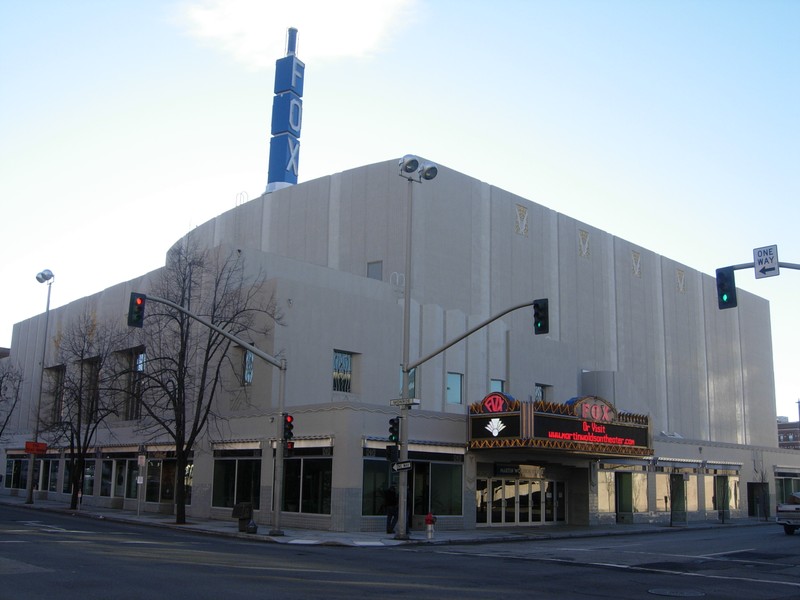Fox Theater (Martin Woldson Theater at the Fox)
Introduction
Text-to-speech Audio
The Fox Theater represents an early twentieth-century period of social history when movie-going existed as truly memorable experience. People dressed in their finest clothes and attended opulent movie theatres, often referred to as "picture palaces." The Fox franchise made movies, distributed them, and owned numerous theaters across the country. By the time Spokane's was built, after the crash of '29, bankers owned the company. Nevertheless, the theater arrived with the same fanfare and existed as a bastion of luxury. Renovations a decade ago allowed it to survive as the current home to Spokane Symphony Orchestra.
Images
By Murderbike - Own work, Public Domain, https://commons.wikimedia.org/w/index.php?curid=3273653

From TripAdvisor.com

Backstory and Context
Text-to-speech Audio
Spokane's Fox Theater, today called the Martin Woldson Theater, opened on September 3, 1931, marked by an event attended by numerous Fox movie stars. Typical of the era, the theater enjoyed sizable sunburst light fixtures, murals, and a first-class staircase leading to the balcony. The Fox Theater concurrently existed as a theater and concert hall for its first thirty years, hosting stars such as Sergei Rachmaninoff, Jascha Heifetz, and Vladimir Horowitz.
Movie mogul William Fox, during the interwar period, built a veritable movie-theater empire, including Spokane's Fox Theater. He had the foresight to realize that owning three aspects of the movie business -- making, distributing, and showing them -- would prove exceptionally profitable, with grand movie palaces serving to lure people to watch movies.
The anticipation of Fox bringing a theater to Spokane created substantial buzz, but the market crash of 1929 created a delay in the arrival of the projected 2,300 seat theater. Indeed, in 1930, Fox had been forced out from the company, which subsequently was sold to bankers in 1931. As a result, Spokane's Fox Theater existed as part of a merged chain called the Fox West Coast Theaters.
Despite ownership changes and the onset of the Great Depression, the Fox still enjoyed first-class, eye-catching features including 3,758 light bulbs ornamenting the building and a sixty-foot-wide sunburst light fixture with etched glass located on the ceiling directly above the orchestra. As well, large murals adorned the walls, and few could miss the grand, double staircase that led to the balconies. The Fox theater also enjoyed modern conveniences such as an early form of air conditioning (called "washed air"),
By the 1950s, the Fox went into decline, but unlike many grand, early twentieth-century movie houses across the country, its demise proved to be short term. In 1975, the Fox had been turned into a triplex movie theater and by 1989 a discount movie house.
However, in 2000, the Spokane Symphony organized an extensive fundraising campaign to purchase the building followed by a second effort to raise funds to renovate and convert it into a dedicated concert hall. The successful campaigns resulted in the buildings 2007 re-opening as the home of the Spokane Symphony and renamed the Martin Woldson Theater at the Fox,
However, in 2000, the Spokane Symphony organized an extensive fundraising campaign to purchase the building followed by a second effort to raise funds to renovate and convert it into a dedicated concert hall. The successful campaigns resulted in the buildings 2007 re-opening as the home of the Spokane Symphony and renamed the Martin Woldson Theater at the Fox,
Sources
Casetti, Francesco. Eye of the Century: Film, Experience, Modernity. New York, Columbia University Press, 2008.
Kershner, Jim. "Fox Theater (Spokane). History Link." historylink.org. Accessed July 02, 2008. http://www.historylink.org/File/8631.
"Original Fox and Opening." Martin Woldson Theater at the Fox. foxtheaterspokane.org. Accessed September 07, 2017. http://foxtheaterspokane.org/original-fox-and-opening/.
Kreisman, Lawrence and Elizabeth Godlewski. "Nomination Form: Fox Theater." National Register of Historic Places. June 30, 2001. https://npgallery.nps.gov/pdfhost/docs/NRHP/Text/01001287.pdf
